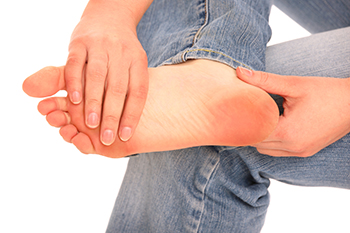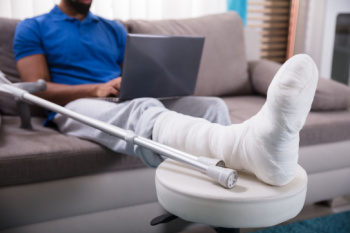
Pain in the ball of the foot occurs when too much pressure is placed on metatarsal heads, the long bones just behind the toes. This condition, termed metatarsalgia, can occur from running, jumping, or standing for long periods. Shoes that are too tight, narrow, or have high heels can push weight forward and strain the front of the foot. Foot shapes like high arches or flat feet can also cause uneven pressure. Bunions, hammertoes, or nerve irritation can add to the pain. Sometimes, small stress fractures or joint inflammation are the cause. The pain can feel sharp, burning, or like walking on a pebble. A podiatrist can check the structure of the foot, look at how you walk, and use imaging to determine the cause. Proper footwear, orthotics, or surgery may be suggested to relieve pressure. If you experience pain in the ball of the foot, it is suggested that you make an appointment with a podiatrist for a diagnosis and treatment.
Foot Pain
Foot pain can be extremely painful and debilitating. If you have a foot pain, consult with one of our podiatrists from Lakewood Family Foot and Ankle. Our doctors will assess your condition and provide you with quality foot and ankle treatment.
Causes
Foot pain is a very broad condition that could be caused by one or more ailments. The most common include:
- Bunions
- Hammertoes
- Plantar Fasciitis
- Bone Spurs
- Corns
- Tarsal Tunnel Syndrome
- Ingrown Toenails
- Arthritis (such as Gout, Rheumatoid, and Osteoarthritis)
- Flat Feet
- Injury (from stress fractures, broken toe, foot, ankle, Achilles tendon ruptures, and sprains)
- And more
Diagnosis
To figure out the cause of foot pain, podiatrists utilize several different methods. This can range from simple visual inspections and sensation tests to X-rays and MRI scans. Prior medical history, family medical history, and any recent physical traumatic events will all be taken into consideration for a proper diagnosis.
Treatment
Treatment depends upon the cause of the foot pain. Whether it is resting, staying off the foot, or having surgery; podiatrists have a number of treatment options available for foot pain.
If you have any questions, please feel free to contact our office located in Lakewood, CA . We offer the newest diagnostic and treatment technologies for all your foot care needs.

A broken foot occurs when one or more of the 26 bones in the foot fracture due to injury or stress. These bones include the metatarsals, phalanges, tarsals, and heel bone, all of which are vital to balance and mobility. A break can result from accidents, falls, sports injuries, or dropping something heavy on the foot. Symptoms vary depending on severity but often include sudden pain, swelling, bruising, and an inability to bear weight. In severe cases, the bone may protrude through the skin or cause visible deformity. People with improper footwear or weakened bones are more likely to experience foot fractures. A podiatrist can help by ordering X-rays to determine the location and extent of the injury and recommend appropriate treatment, which may involve immobilization or surgery. If you have broken a bone in the foot, it is suggested that you make an appointment with a podiatrist for a diagnosis and guidance on returning to activities.
A broken foot requires immediate medical attention and treatment. If you need your feet checked, contact one of our podiatrists from Lakewood Family Foot and Ankle. Our doctors can provide the care you need to keep you pain-free and on your feet.
Broken Foot Causes, Symptoms, and Treatment
A broken foot is caused by one of the bones in the foot typically breaking when bended, crushed, or stretched beyond its natural capabilities. Usually the location of the fracture indicates how the break occurred, whether it was through an object, fall, or any other type of injury.
Common Symptoms of Broken Feet:
- Bruising
- Pain
- Redness
- Swelling
- Blue in color
- Numbness
- Cold
- Misshapen
- Cuts
- Deformities
Those that suspect they have a broken foot shoot seek urgent medical attention where a medical professional could diagnose the severity.
Treatment for broken bones varies depending on the cause, severity and location. Some will require the use of splints, casts or crutches while others could even involve surgery to repair the broken bones. Personal care includes the use of ice and keeping the foot stabilized and elevated.
If you have any questions, please feel free to contact our office located in Lakewood, CA . We offer the newest diagnostic and treatment technologies for all your foot care needs.

Preventing falls at home begins with creating a safe and supportive environment. Start by checking all walking surfaces to ensure they are even, dry, and free of loose rugs. Good lighting is essential and helps you see obstacles clearly, especially in hallways and stair areas. Rearranging furniture to open pathways and removing clutter can greatly reduce the risk of tripping. Falls can lead to foot conditions, such as sprains, fractures, heel pain, and tendon injuries that may worsen without proper care. A podiatrist can evaluate any foot or ankle injury, improve stability, recommend supportive footwear, and provide fall prevention guidance tailored to your needs. If you have injured your foot or ankle from falling, it is suggested that you consult a podiatrist who can treat these types of injuries, and guide you on additional fall prevention tips.
Preventing falls among the elderly is very important. If you are older and have fallen or fear that you are prone to falling, consult with one of our podiatrists from Lakewood Family Foot and Ankle. Our doctors will assess your condition and provide you with quality advice and care.
Every 11 seconds, an elderly American is being treated in an emergency room for a fall related injury. Falls are the leading cause of head and hip injuries for those 65 and older. Due to decreases in strength, balance, senses, and lack of awareness, elderly persons are very susceptible to falling. Thankfully, there are a number of things older persons can do to prevent falls.
How to Prevent Falls
Some effective methods that older persons can do to prevent falls include:
- Enrolling in strength and balance exercise program to increase balance and strength
- Periodically having your sight and hearing checked
- Discuss any medications you have with a doctor to see if it increases the risk of falling
- Clearing the house of falling hazards and installing devices like grab bars and railings
- Utilizing a walker or cane
- Wearing shoes that provide good support and cushioning
- Talking to family members about falling and increasing awareness
Falling can be a traumatic and embarrassing experience for elderly persons; this can make them less willing to leave the house, and less willing to talk to someone about their fears of falling. Doing such things, however, will increase the likelihood of tripping or losing one’s balance. Knowing the causes of falling and how to prevent them is the best way to mitigate the risk of serious injury.
If you have any questions, please feel free to contact our office located in Lakewood, CA . We offer the newest diagnostic and treatment technologies for all your foot care needs.

